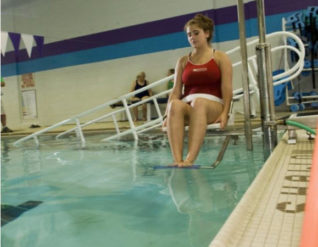Aquatic exercise and adaptive swimming are excellent ways for physically disabled individuals to not only get and stay fit, but also to improve range of motion, balance, flexibility, cardiovascular fitness and muscle strength. Almost anyone with a disability can participate in adaptive swimming for fun, exercise or competition, because the water acts as a support mechanism buoying the body and most can move through the water without assistance. However, it is recommended to use flotation devices when first starting to swim with a disability. These can be removed as swimmers gain confidence and understand their abilities in the water.
Why Swimming Is Good for Individuals with a Disability (5:33)
Recreational Swimming as a Paraplegic (1:00)
Using Pool Buoys to Help Paraplegic Swim (3:16)
Swimming without Arms (5:10)
What to Look for in an Aquatic Facility for Disabled Swimming
A few things to consider when assessing the accessibility of an aquatic facility are:
- Staff’s understanding of the needs of people with disabilities
- Access to pool
- Grade entry of pool (zero grade is ideal)
- Lift – can it be operated independently or does it require assistance
- Flotation or other assistive equipment
- Location of bathrooms and changing areas
- Water temperature
- Pool type – recreational or for exercise
Getting in and out of Pool
Getting into Pool from Wheelchair by Yourself (2:16)
From Wheelchair to Pool Using a Bench (3:09)
Get Out of Pool and into Wheelchair (1:07)
Using Chair Lift to Get in Pool (1:43)
Paraplegic Pool Entry, Exit, and Swim Techniques (9:46)
Additional Resources
Paralympic Swimming
US National Team Swimming — Adaptive Swimming
Learn about para sports events to get an idea about what’s out there and to find some ways to participate.


Leave a Reply